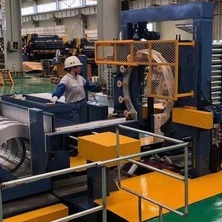Roll packaging plays a crucial role in safeguarding the integrity and quality of stainless steel rolls and alloy rolls throughout the handling, transportation, and storage processes. Let’s explore why proper roll packaging is of utmost importance.
I. Protecting Stainless Steel Rolls and Alloy Rolls
Handling and transporting rolls present unique challenges due to their size, weight, and structural properties. Without proper packaging, rolls are vulnerable to various risks, including:
A. Challenges in Handling and Transporting Rolls
Tangling and Overlapping: Rolls that are not separated and secured properly can become tangled or overlap during transportation, leading to difficulties in handling and potential damage.
Vibration and Impact: Vibrations and impacts during transportation can cause rolls to shift, resulting in deformation, misalignment, or even physical damage.
Moisture and Corrosion: Exposure to moisture or corrosive elements can lead to rust formation on stainless steel and alloy rolls, compromising their structural integrity and surface finish.
B. Need for Secure and Reliable Packaging
To mitigate these risks, it is essential to employ secure and reliable packaging methods specifically designed for roll protection. Proper roll packaging offers the following benefits:
Stability and Load Distribution: Well-packaged rolls are secured and stabilized, preventing movement or shifting during transportation. This ensures that the weight is evenly distributed, reducing the risk of damage caused by imbalanced loads.
Protection Against External Factors: Rolls are shielded from external elements such as moisture, dust, and contaminants, preserving their original condition and preventing corrosion or surface damage.
Prevention of Dents and Scratches: Proper packaging materials, such as protective films or padding, create a barrier between rolls, minimizing the risk of dents, scratches, and other cosmetic damages.
II. Ensuring Roll Integrity and Quality
Improper packaging can significantly impact the shape, condition, and overall quality of stainless steel rolls and alloy rolls. Consider the following:
A. Impact of Improper Packaging on Roll Shape and Condition
Roll Deformation: Inadequate packaging can cause rolls to deform due to pressure, stacking, or insufficient support, leading to shape irregularities and difficulties in subsequent processing.
Misalignment and Roll Distortion: Rolls that are not properly aligned or packaged may experience distortion, affecting their dimensional accuracy and suitability for further manufacturing processes.
Surface Damage: Without protective packaging, rolls are susceptible to surface damage, including scratches, dents, or abrasions, which can compromise their appearance and functionality.
Roll packing lines play a vital role in efficiently handling and packaging stainless steel rolls and alloy rolls. Let’s delve into the various aspects of a roll packing line to understand its significance and the steps involved in the process.
I. Roll Separation and Alignment
Proper roll separation is crucial to ensure smooth packaging operations. Rolls need to be separated with precision, allowing adequate space between them. This step guarantees that each roll can be handled individually and prevents tangling or overlapping during subsequent processes. By maintaining proper alignment, the packaging line can operate efficiently, minimizing the risk of errors or disruptions.
II. Strapping and Securing Rolls
Once the rolls are separated and aligned correctly, they need to be securely strapped to maintain their integrity throughout transportation and storage. Roll packing lines utilize various strapping materials, such as steel or polyester bands, to tightly secure the rolls. Additionally, different strapping techniques, including manual or automated processes, are employed based on the specific requirements of the rolls. Secure strapping offers stability, preventing any movement or shifting during handling, and ensures the safety of the rolls and those involved in the logistics process.
III. Weighing and Labeling
Accurate roll weight measurement is of utmost importance in the packaging process. Roll packing lines incorporate weighing systems that precisely measure the weight of each roll. This information not only helps in determining the appropriate packaging materials but also assists in managing inventory and logistics. Furthermore, labeling each roll with identification and traceability information, including product details, batch numbers, and manufacturing dates, ensures easy identification and tracking throughout the supply chain.
IV. Stacking and Palletizing
Efficient stacking techniques are employed to optimize space utilization and ensure safe packaging. The roll packing line arranges the strapped rolls in a systematic manner, minimizing unnecessary gaps and maximizing the use of available space. This organized stacking not only facilitates easy loading and unloading but also prevents roll damage during transportation. To further enhance safety and convenience, pallets are commonly used for stacking and supporting the rolls. Palletizing provides stability, protects the rolls from impacts, and enables efficient handling using forklifts or other equipment.
V. Transportation and Handling
Preparing the rolls for transportation is a critical step in the roll packing line. This involves securely loading the stacked rolls onto suitable transport vehicles, such as trucks or containers, while ensuring proper weight distribution and balance. Careful consideration is given to factors like securing the load, using appropriate restraints, and implementing safety measures to prevent any shifting or damage during transit. Similarly, during unloading, proper handling techniques are employed to minimize the risk of accidents and ensure the rolls remain intact and undamaged.
By incorporating these essential steps, a roll packing line ensures that stainless steel rolls and alloy rolls are handled, packaged, and transported efficiently and securely. The systematic approach provided by the roll packing line minimizes the risk of damage, optimizes productivity, and contributes to the overall success of the roll manufacturing and distribution process.






Reviews
There are no reviews yet.